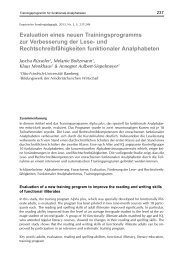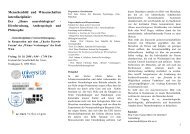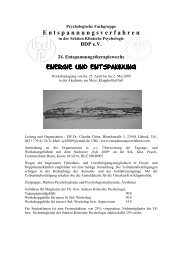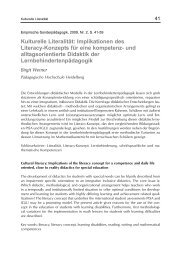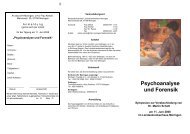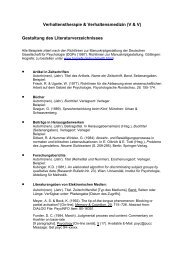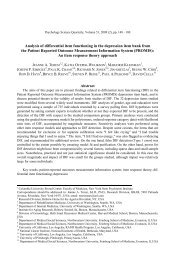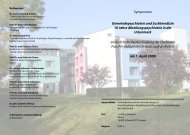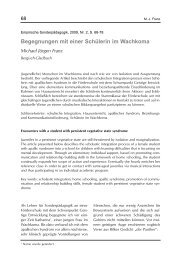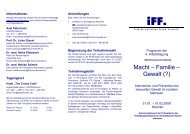Scale construction and evaluation in practice: A review of factor ...
Scale construction and evaluation in practice: A review of factor ...
Scale construction and evaluation in practice: A review of factor ...
You also want an ePaper? Increase the reach of your titles
YUMPU automatically turns print PDFs into web optimized ePapers that Google loves.
<strong>Scale</strong> <strong>construction</strong> <strong>and</strong> <strong>evaluation</strong> <strong>in</strong> <strong>practice</strong> 285<br />
criterion is not very useful. In one study (Beyers, Goossens, Calster, & Duriez, 2005),<br />
the criteria used for item retention are not made explicit.<br />
Reliability<br />
Reliability refers to the consistency <strong>of</strong> measurement – that part <strong>of</strong> a measure that is free<br />
<strong>of</strong> r<strong>and</strong>om error (Bollen, 1989, p. 206 ff.). The reliability <strong>of</strong> a scale is estimated <strong>in</strong> 35 <strong>of</strong><br />
the studies (85 %), usually by comput<strong>in</strong>g Cronbach’s α for each subscale. It is remarkable<br />
that α is still the most commonly used reliability measure, even though other coefficients,<br />
like the lower bounds proposed by Guttman (1945), provide greater lower bounds<br />
to reliability (e.g., Jackson & Agunwamba, 1977; see also Z<strong>in</strong>barg, Revelle, Yovel, & Li,<br />
2005). Moreover, research on the behavior <strong>of</strong> α (e.g., Cort<strong>in</strong>a, 1993; see also Sijtsma,<br />
2009a, for a historical overview) does not seem to be well known among applied researchers.<br />
Cort<strong>in</strong>a criticized the <strong>practice</strong> <strong>of</strong> compar<strong>in</strong>g α to a cut<strong>of</strong>f value, like .70 or .80,<br />
without any consideration <strong>of</strong> context, s<strong>in</strong>ce the <strong>in</strong>terpretation <strong>of</strong> α depends on many<br />
<strong>factor</strong>s, such as test length <strong>and</strong> sample homogeneity. Recently, the use <strong>of</strong> α was criticized<br />
<strong>and</strong> discussed aga<strong>in</strong> (Bentler, 2009; S. B. Green & Yang, 2009a, 2009b; Revelle & Z<strong>in</strong>barg,<br />
2009; Sijtsma, 2009a, 2009b), with recommendations for alternative reliability<br />
estimators <strong>and</strong> s<strong>of</strong>tware to employ them. Furthermore, confidence <strong>in</strong>tervals for α<br />
(Iacobucci & Duhachek, 2003; Kon<strong>in</strong>g & Franses, 2003) are hardly ever reported (three<br />
studies, 7 %), even though they provide a means <strong>of</strong> compar<strong>in</strong>g α values from different<br />
studies.<br />
In the studies where a nonparametric Mokken IRT analysis is applied, reliability is estimated<br />
based on the so-called P(++) matrices. In parametric IRT, one traditionally focuses<br />
on item <strong>and</strong> test <strong>in</strong>formation functions, because the measurement error <strong>of</strong> a scale is a<br />
function <strong>of</strong> the latent variable values. However, <strong>in</strong> only one <strong>of</strong> the three parametric IRT<br />
applications (Caprara, Steca, Zelli, & Capanna, 2005) are <strong>in</strong>formation curves exam<strong>in</strong>ed<br />
to assess reliability. Furthermore, <strong>in</strong> none <strong>of</strong> the studies are reliability measures developed<br />
with<strong>in</strong> the IRT tradition, such as marg<strong>in</strong>al reliability (B. F. Green, Bock, Humphreys,<br />
L<strong>in</strong>n, & Reckase, 1984) or EAP reliability (Adams, 2005), reported.<br />
In 12 <strong>of</strong> the 34 studies report<strong>in</strong>g on a multidimensional scale, a composite reliability<br />
measure is provided. In most cases, this is done by comput<strong>in</strong>g α for the entire set <strong>of</strong> items<br />
taken together, even though more sophisticated composite reliability measures, like<br />
weighted ω (e.g., Bacon, Sauer, & Young, 1995; McDonald, 1970; see also Raykov &<br />
Shrout, 2002) are available. Weighted ω is reported <strong>in</strong> only one study (Clark et al.,<br />
2005). Reliance on the value <strong>of</strong> α as a lower bound to composite reliability is not justified,<br />
as shown by Raykov (1998). He argued that α can be an overestimation (rather than<br />
an underestimation) <strong>of</strong> the composite reliability <strong>of</strong> a scale when the items have correlated<br />
errors.



